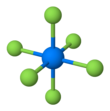Plutonium hexafluoride
You can help expand this article with text translated from the corresponding article in German. (November 2012) Click [show] for important translation instructions.
|

| |||
| |||
| Names | |||
|---|---|---|---|
| IUPAC name
plutonium(VI) fluoride
| |||
| Identifiers | |||
3D model (JSmol)
|
|||
| ChemSpider | |||
PubChem CID
|
|||
CompTox Dashboard (EPA)
|
|||
| |||
| |||
| Properties | |||
| PuF 6 | |||
| Appearance | Dark red, opaque crystals | ||
| Density | 5.08 g·cm−3 | ||
| Melting point | 52 °C (126 °F; 325 K) | ||
| Boiling point | 62 °C (144 °F; 335 K) | ||
| Structure | |||
| Orthorhombic, oP28 | |||
| Pnma, No. 62 | |||
| octahedral (Oh) | |||
| 0 D | |||
| Related compounds | |||
Related fluoroplutoniums
|
Plutonium trifluoride | ||
| Hazards | |||
| NFPA 704 (fire diamond) | |||
Except where otherwise noted, data are given for materials in their standard state (at 25 °C [77 °F], 100 kPa).
| |||
Plutonium hexafluoride is the highest fluoride of plutonium, and is of interest for laser enrichment of plutonium, in particular for the production of pure plutonium-239 from irradiated uranium. This pure plutonium is needed to avoid premature ignition of low-mass nuclear weapon designs by neutrons produced by spontaneous fission of plutonium-240.
It is a red-brown volatile crystalline solid;[1] the heat of sublimation is 12.1 kcal/mol[2] and the heat of vaporization 7.4 kcal/mol.[2] It is relatively hard to handle, being very corrosive and prone to auto-radiolysis.[3][4]
It is prepared by fluorination of plutonium tetrafluoride (PuF4) by powerful fluorinating agents such as elemental fluorine.[2][5][6][7]
- PuF
4 + F
2 → PuF
6
It can also be obtained by fluorination of plutonium(III) fluoride or plutonium(IV) oxide.[6]
- 2 PuF
3 + 3 F
2 → 2 PuF
6
- PuO
2 + 3 F
2 → PuF
6 + O
2
In 1984, the synthesis of plutonium hexafluoride was achieved at unprecedented low temperatures through the use of dioxygen difluoride. Previous techniques needed temperatures so high that the plutonium hexafluoride produced would decompose rapidly.[8] Hydrogen fluoride is not sufficient;[9] even though it is a powerful fluorinating agent.
Under laser irradiation at a wavelength of less than 520 nm, it decomposes to plutonium pentafluoride and fluorine;[10] after more irradiation it decomposes further to plutonium tetrafluoride.[11]
References
- ^ a b Lide, David R. (2009). Handbook of Chemistry and Physics (90 ed.). Boca Raton, Florida: CRC Press. pp. 4–81. ISBN 978-1-4200-9084-0. (webelements.com)
- ^ a b c Florin, Alan E.; Tannenbaum, Irving R.; Lemons, Joe F. (1956). "Preparation and properties of plutonium hexafluoride and identification of plutonium(VI) oxyfluoride". Journal of Inorganic and Nuclear Chemistry. 2 (5–6): 368–379. doi:10.1016/0022-1902(56)80091-2.
- ^ Bibler, Ned E. (23 August 1979). "α and β Radiolysis of Plutonium Hexafluoride Vapor". J. Phys. Chem. 83 (17): 2179–2186. doi:10.1021/j100480a001.
- ^ Steindler, M.J.; Steidl, D.V.; Fischer, J. (November 1964). "The decomposition of plutonium hexafluoride by gamma radiation". Journal of Inorganic and Nuclear Chemistry. 26 (11): 1869–1878. doi:10.1016/0022-1902(64)80011-7.
- ^ A. E. Florin (9 November 1950). "Plutonium Hexafluoride: Second Report On The Preparation and Properties (LA-1168)" (PDF). Los Alamos Scientific Laboratory.
- ^ a b Mandleberg, C.J.; Rae, H.K.; Hurst, R.; Long, G.; Davies, D.; Francis, K.E. (1956). "Plutonium hexafluoride". Journal of Inorganic and Nuclear Chemistry. 2 (5–6): 358–367. doi:10.1016/0022-1902(56)80090-0.
- ^ Weinstock, Bernard; Malm, John G. (July 1956). "The properties of plutonium hexafluoride". Journal of Inorganic and Nuclear Chemistry. 2 (5–6): 380–394. doi:10.1016/0022-1902(56)80092-4.
- ^ Malm, J. G.; Eller, P. G.; Asprey, L. B. (1984). "Low temperature synthesis of plutonium hexafluoride using dioxygen difluoride". Journal of the American Chemical Society. 106 (9): 2726–2727. doi:10.1021/ja00321a056.
- ^ Evaluation of the U.S. Department of Energy's Alternatives for the Removal and Disposition of Molten Salt Reactor Experiment Fluoride Salts. 1997. p. 42. doi:10.17226/5538. ISBN 978-0-309-05684-7.
- ^ US 4670239, Sherman W. Rabideau & George M. Campbell, "Photochemical Preparation of Plutonium Pentafluoride", published June 2, 1987, assigned to The United States of America
- ^ Lobikov, E. A.; Prusakov, V. N.; Serik, V. F. (August–September 1992). "Plutonium Hexafluoride Decomposition under the Action of Laser Radiation". Journal of Fluorine Chemistry. 58 (2–3): 277. doi:10.1016/S0022-1139(00)80734-4.



